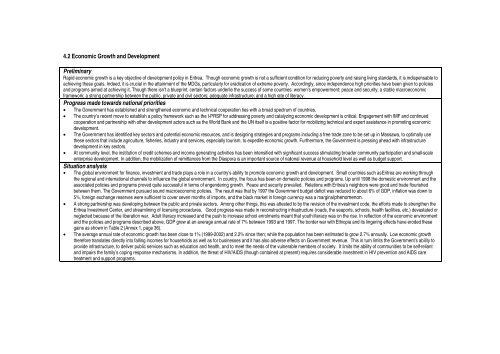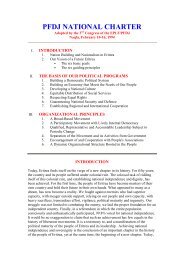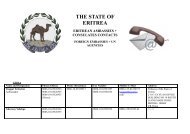Common Country Assessment (CCA) - ECSS | Eritrean Center for ...
Common Country Assessment (CCA) - ECSS | Eritrean Center for ...
Common Country Assessment (CCA) - ECSS | Eritrean Center for ...
Create successful ePaper yourself
Turn your PDF publications into a flip-book with our unique Google optimized e-Paper software.
4.2 Economic Growth and Development<br />
Preliminary<br />
Rapid economic growth is a key objective of development policy in Eritrea. Though economic growth is not a sufficient condition <strong>for</strong> reducing poverty and raising living standards, it is indispensable to<br />
achieving these goals. Indeed, it is crucial in the attainment of the MDGs, particularly <strong>for</strong> eradication of extreme poverty. Accordingly, since independence high priorities have been given to policies<br />
and programs aimed at achieving it. Though there isn’t a blueprint, certain factors underlie the success of some countries: women’s empowerment; peace and security; a stable macroeconomic<br />
framework; a strong partnership between the public, private and civil sectors; adequate infrastructure; and a high rate of literacy.<br />
Progress made towards national priorities<br />
• The Government has established and strengthened economic and technical cooperation ties with a broad spectrum of countries.<br />
• The country’s recent move to establish a policy framework such as the I-PRSP <strong>for</strong> addressing poverty and catalyzing economic development is critical. Engagement with IMF and continued<br />
cooperation and partnership with other development actors such as the World Bank and the UN itself is a positive factor <strong>for</strong> mobilizing technical and expert assistance in promoting economic<br />
development.<br />
• The Government has identified key sectors and potential economic resources, and is designing strategies and programs including a free trade zone to be set up in Massawa, to optimally use<br />
these sectors that include agriculture, fisheries, industry and services, especially tourism, to expedite economic growth. Furthermore, the Government is pressing ahead with infrastructure<br />
development in key sectors.<br />
• At community level, the institution of credit schemes and income generating activities has been intensified with significant success stimulating broader community participation and small-scale<br />
enterprise development. In addition, the mobilization of remittances from the Diaspora is an important source of national revenue at household level as well as budget support.<br />
Situation analysis<br />
• The global environment <strong>for</strong> finance, investment and trade plays a role in a country’s ability to promote economic growth and development. Small countries such as Eritrea are working through<br />
the regional and international channels to influence the global environment. In country, the focus has been on domestic policies and programs. Up until 1998 the domestic environment and the<br />
associated policies and programs proved quite successful in terms of engendering growth. Peace and security prevailed. Relations with Eritrea’s neighbors were good and trade flourished<br />
between them. The Government pursued sound macroeconomic policies. The result was that by 1997 the Government budget deficit was reduced to about 6% of GDP, inflation was down to<br />
5%, <strong>for</strong>eign exchange reserves were sufficient to cover seven months of imports, and the black market in <strong>for</strong>eign currency was a marginal phenomenon.<br />
• A strong partnership was developing between the public and private sectors. Among other things, this was attested to by the revision of the investment code, the ef<strong>for</strong>ts made to strengthen the<br />
Eritrea Investment <strong>Center</strong>, and streamlining of licensing procedures. Good progress was made in reconstructing infrastructure (roads, the seaports, schools, health facilities, etc.) devastated or<br />
neglected because of the liberation war. Adult literacy increased and the push to increase school enrolments meant that youth literacy was on the rise. In reflection of the economic environment<br />
and the policies and programs described above, GDP grew at an average annual rate of 7% between 1993 and 1997. The border war with Ethiopia and its lingering effects have eroded these<br />
gains as shown in Table 2 (Annex 1, page 36).<br />
• The average annual rate of economic growth has been close to 1% (1999-2002) and 2.2% since then; while the population has been estimated to grow 2.7% annually. Low economic growth<br />
there<strong>for</strong>e translates directly into falling incomes <strong>for</strong> households as well as <strong>for</strong> businesses and it has also adverse effects on Government revenue. This in turn limits the Government’s ability to<br />
provide infrastructure, to deliver public services such as education and health, and to meet the needs of the vulnerable members of society. It limits the ability of communities to be self-reliant<br />
and impairs the family’s coping response mechanisms. In addition, the threat of HIV/AIDS (though contained at present) requires considerable investment in HIV prevention and AIDS care<br />
treatment and support programs.





